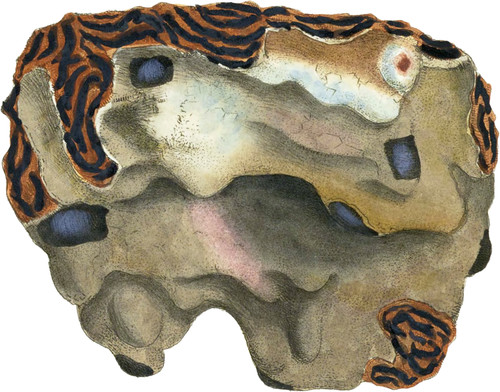 Enlarge
Enlarge
British Mineralogy
Stalactitical Oxide of Iron
- Class 3. Metals.
- Order 1. Homogeneous.
- Gen. 8. Iron.
- Spec. 3. Oxide of.
This is another remarkable stalactitical production from Mam-Tor in Derbyshire. It was given me by my friend N. J. Winch, Esq., F.L.S. of Newcastle, and has been taken for Mineral Pitch, as its appearance would warrant us to suppose. it is however found to be an Oxide of Iron. Its situation is nearly as remarkable, when carefully examined, as that of the last; for its being so distinctly formed above the calcareous stalactite, gives an idea of its being a lighter substance. This might appear impossible: Nature, however, is seldom at variance with herself, and by a steady observance we may reconcile these apparent difficulties. It might happen that water very readily took up the Oxide of Iron which it found in its passage through the matrix, and, by dropping into some hollow, formed a stalactite, often coated by that which follows, and which was not so soon dissolved, or so soon fitted for precipitation. Some of its coats are in such a state that they resemble Martial Ethiops.
It comes near to the appearance of Hæmatites; it however has not the striated character, but rather the conchoidal fracture of Pitch. A little heat renders it magnetic, but does not take much of the blackness off: perhaps it contains a little Manganese, as the ochraceous part becomes somewhat crimson with heat.
A small degree of heat would melt it, if it were Pitch. This is a sort of proof of a natural application of a chemical trial necessary in Mineralogy.
The ochraceous part of the first sight resembles a parcel of leaves from a chalybeate spring, and is of as deep an orange-colour as any I have seen.
The calcareous part may be the Calx sinter of Werner, which is a sort of crystallized stalactite, and the fracture is more or less distinct in this specimen, as well internally as externally. It seems to have been formed after the Iron, by nearly the same process, but was retained longer by the water.

